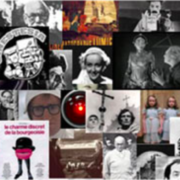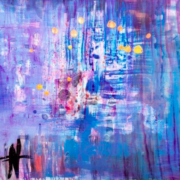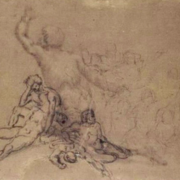Cinema, Psychology, Psychoanalysis and Mental Distress: General Bibliography
In the General Bibliography there are works that are related in several ways to the wide field of studies devoted to the relationship between film, psychoanalysis and mental distress. This collection, even if substantial, is not intended to be either exhaustive or judgemental. Items are listed alphabetically; any thematic classification is left to the curiosity of the reader. There are works written not only by psychoanalysts, but also by philosophers, film critics, semiologists, men of letters. Indeed, after an initial period in which this topic has been developed mainly through psychoanalysts’ publications in specialized journals, by the end of the ‘60s many disciplines were dealing with the subject and a large number of journals, film ones as well, were publishing these works: let us mention the special monographic issue of the French Journal Communications – a French journal focused on semiology – , released in1975 with the title Psychanalyse et Cinéma, hosting articles by Barthes, Baudry, Guattari, Metz and others. Other items belongs to semiology and film theory, that use psychoanalytic concepts in their analysis: for instance, Christian Metz , one of the most widely known semiologists interested in film, drew much on Lacan’s theory; or Ikon – a Journal hosting articles in the fields of psychology, sociology, semiology and social sciences in general – published by the Institute of Research on Communication, founded by A. Gemelli and C. Musatti, in 1962 acquired the French Revue International de Filmologie, confirming the interdisciplinarity of the subject. The final section gathers special issues of journals entirely dedicated to the relationship between psychoanalysis and film, and includes their respective table of contents.
Abruzzese, A. (1974) L’immagine filmica [The Film Image]. Roma: Bulzoni.
Agnel, A. (1995) see Cahiers jungiens de psychanalyse, 83.
Albano, L. (1986) Il visibile e il non visibile [The Visible and the Invisible]. Filmcritica, pp. 365-366.
Albano, L. (1992) La caverna dei giganti: Scritti sull’evoluzione del dispositivo cinematografico [The Giants’ Cave: Writings on the Evolution of the Cinema as a Device]. Parma: Pratiche.
Albano, L. (2003) Cinema e Surrealismo: Tra oggetto-sogno e spazio-sogno [Cinema and Surrealism: In between dream-object and dream-space]. In G. Orlandi Cerenza (ed.) Traiettorie della modernità: Il Surrealismo all’alba del Terzo Millennio [Paths of modernity: Surrealism at the third millennium dawn]. Torino: Lindau.
Albano, L. (2004) Lo schermo dei sogni: Chiavi psicoanalitiche del cinema [Dreams’ screen: Psychoanalytic interpretations of cinema]. Venezia: Marsilio.
Albano, L. (2005a) L’amore impossibile e l’oggetto perduto [Impossible love and the lost object]. In E. Dagrada (ed.) Il Melodramma [The Melodrama]. Roma: Bulzoni.
Albano, L. (2005b) see La Valle dell’Eden, n. 15.
Albano, L., Pravadelli, V. (eds.) (2008) Cinema e psicoanalisi: Tra cinema classico e nuove tecnologie [Cinema and Psychoanalysis: From classic cinema to new technologies]. Macerata: Quodlibet.
Albertini, L., Caruso, A.P. (1949) Percezione e interpretazione di immagini cinematographiche nei ragazzi [Perception and interpretation of images cinematographiche in boys]. Bianco e Nero, X, pp. 9-27.
Alexander ,M., Hall, M.N., Pettice, Y.J. (1994) Cinemeducation: An Innovative Approach to Teaching Psychosocial Medical Care. Fam. Med., 26, pp. 430-433.
Allen, R. (1993a) Cinema, Psychoanalysis, and the Film Spectator. Persistence of Vision, 10, pp. 5-33.
Allen, R. (1993b) Representation, Illusion, and the Cinema. Cinema Journal, 32, 2, pp. 21-48.
Allen, R. (1995) Projecting Illusion: Film Spectatorship and the Impression of Reality. New York: Cambridge University Press.
Allen, R. (1997) Looking at Motion Pictures. In R. Allen, M. Smith (eds.) Film Theory and Philosophy. Oxford: Clarendon Press.
Allen, R. (1999) Psychoanalytic Film Theory. In R. Stam, T. Miller (eds.) A Companion to Film Theory, Oxford: Blackwell.
Allen, R.C. (1990) From Exhibition to Reception: Reflections on the Audience in Film History. Screen, 31, n. 4, pp. 347-357.
Allendy, R. (1926) La valeur psychologique de l’image [The psychological value of the image]. L’Art Cinématographique, I, pp. 75-103.
Alloway, L. (1971) Violent America: The Movies, 1946-1964. New York: Museum of Modern Art.
Almansi, R.J. (1992) Alfred Hitchcock’s Disappearing Women: Scopophilia, Object Loss. Int. Rev. Psycho-Anal., 19, pp. 81-90.
Altman, C.F. (1977) Psychoanalysis and the Cinema: The Imaginary Discourse. Quarterly Review of Film Studies, 2, n. 3, pp. 257-272.
Ancona, L. (1963) Il film come elemento nella dinamica dell’aggressività [The film as an element in aggressiveness dynamics]. Ikon, 16(46), pp. 27-32.
Ancona, L., Bertini, M. (1963) Aggressivity Discharge Effect through Films Causing Strong Emotional Stress. Ikon, 19(57), pp. 7-27.
Ancona, L., Carli, R. (1970) La dinamica della partecipazione cinematografica [Dynamics of cinematic participation]. Contributi dell’Istituto di Psicologia, U.C.S.C., 30, pp. 21-45.
Ancona, L., Croce, M.A. (1967) Dinamica psichica e dinamismo cinematografico [Psychic Dynamics and cinema dynamism]. Arch. Psicol. Neurol. Psich., 28, pp. 85-106.
Ancona, L., Fontanesi, M. (1967) Analisi delle relazioni dinamiche tra effetto catartico e effetto frustante di uno stimolo cinematografico emotivo [Analysis of the dynamic relationships between cathartic and frustrating effect of a stimulus emotional film]. Contributi dell’Istituto di Psicologia, U.C.S.C., 28, pp. 30-48.
Anderson, B. (1980) Eye Movement and Cinematic Perception. Journal of the University Film Association, 32, pp. 23-26.
Anderson, J.D. (1993a) A Cognitive Approach to Continuity. Post Script, 13(1), pp. 61-66.
Anderson, J.D. (1993b) Sound and Image Together: Cross-Modal Confirmation. Wide Angle, 15 (1), pp. 30-43.
Anderson, J.D. (1996) The Reality of Illusion: An Ecological Approach to Cognitive Film Theory. Carbondale: Southern Illinois University Press.
Anderson, J.D. (2002) Scene and Surface in the Cinema: Implications for Realism. Cinémas, 12(2), pp. 11-21.
Anderson, J.D., Hodgins, J.K. (2005) Perceiving Human Motion in Synthesised Images. In J.D. Anderson, B. Anderson (eds.) Moving Image Theory: Ecological Considerations. Carbondale: Southern Illinois University Press.
Anderson, J.D., Hodgins, J.K. (2005) Perceiving Human Motion in Synthesised Images. In J.D. Anderson, B. Anderson (ed.) Moving Image Theory: Ecological Considerations. Carbondale: Southern Illinois University Press.
Anderson, L., Shimamura, A.P. (2005) Influences of Emotion on Context Memory While
Viewing Film Clips. American Journal of Psychology, 118(3), pp. 323-337.
Andrade, C., Shah, N., Venkatesh, BK. (2010) The Depiction of Electroconvulsive Therapy in Hindi Cinema. Journal of ECT, 26(1), pp. 16-22.
Angelini, A. (1992) La psicologia del cinema [The Psychology of the Film]. Napoli: Liguori.
Anzieu, D. (1977) L’image, le texte et la pensée [The image, the text and the thought]. Nouv. Rev. Psychanalyse, 16, pp. 119-134.
Argentieri, S. (1991) Il ridicolo e il sublime: Cinema umoristico e tirannia [From the Ridiculous to the Sublime :Humorous film and tyranny]. In M. Argentieri (ed.) Risate di regime: La commedia italiana 1930-1944 [Laughter and Regime: Italian comedy]. Venezia: Marsilio.
Argentieri, S., Sapori, A. (1988) Freud a Hollywood [Freud in Hollywood]. Torino: Nuova ERI.
Aromi, A. (2006) see La Psicoanalisi, n. 40.
Arnehim, R. (1932) Film als Kunst. Berlin: Rowohlt (en. trans. Film as Art, Berkeley: University of California Press, 1957).
Arnehim, R. (1954) Art and Visual Perception: A Psychology of the Creative Eye. Berkeley: University of California Press.
Atkinson J. M. (1997) The psychiatrist, the patient, their relationship and the movies. Psychiatric Bulletin, 21, pp. 369-370.
Atwood, G.E. (1978) The Impact of Sybil on a Patient with Multiple Personality. Am. J. Psychoanal., 38, pp. 277-279.
Audibert, L. (1978) Le noir et blanc du rêve [Dream’s black and white]. Cinématographe, n. 35, pp. 7-10.
Augst, B. (1985) The Lure of Psychoanalysis: Film Theory. Camera Obscura, pp. 415-437.
Aulas, J.J. (1980) La folie dans le cinéma allemand [The madness in German cinema]. (1913-1933). Ann. Méd. Psychol.,138(2), pp. 925-938.
Aumont, J. (1971) Eisenstein avec Freud. Notes sur “Le mal voltarien” [Eisenstein with Freud. Notes on “The damage voltarien”]. Cahiers du cinéma, 226-227, pp. 68-74.
Aumont, J., Marie, M. (1988) L’analyse des films [Film Analysis]. Paris: Nathan.
Aumont, J., Bergala, A., Marie, M., Vernet, M. (1994) Estetique du film. Paris: Nathan (en. trans. Aesthetics of Film, Mishawaka: Better World Books).
Bächler, O. (1989) see Cinémaction, n. 50.
Bailey, J. (1989) see Psychoanalytic Inquiry, vol. 18, n. 2.
Baird, R. (2000) The Startle Effect: Implications for Spectator Cognition and Media Theory. Film Quarterly, 53(3), pp. 12-24.
Bak, R. (1968) The Phallic Woman: The Ubiquitous Fantasy in Perversions. Psychoan. Study Child, 23, pp. 15-63.
Balestieri, M., Caracciolo, S., Dalle Luche, R., Iazzetta, P., Senatore, I. (2010) Vero come la finzione [As True as Fiction], vol. 1 e 2. Milano: Springer.
Ballhausen, T., Krenn, G., Marinelli, L. (eds.) (2006) Psyche im Kino: Sigmund Freud und der Film [Psyche in the cinema: Sigmund Freud and the film]. Wien: Filmarchiv Austria.
Balsam, R.H. (reported by) (1996) Panel Report: Psychic Reality and Films, Chaired by H. Kimble Wrye. Int. J. Psycho-Anal., 77, pp. 595-599.
Barbera, A., Turigliatto, R. (1978) Leggere il cinema [Reading the cinema]. Milano: Mondatori.
Baroni, M.R, Cornoldi, C., De Beni, R, D’Urso, V., Palomba, D., Mainardi Peron, E., Stegnano, L. (1989) Emozioni in celluloide [Emotions on Films]. Milano: Raffaello Cortina.
Barthes, R. (1960) Le Problème de la signification au cinéma [The problem of meaning in film]. Rev. int. de filmologie, X, pp. 32-33.
Barthes, R. (1971) De l’œuvre au text. Revue d’Esthétique, 3, pp. 225-232 (en. trans. From Work to Text, in P. Rice, P. Waugh [eds.] Modern Literary Theory: A Reader, London: Edward Arnold, 1989).
Barthes, R. (1960-1970) Sul cinema [On the cinema], edited by S. Toffetti. Genova: Il Melangolo, 1994.
Barthes, R. (1975) see Communications, n. 23.
Bartsch, A. (2008) Meta-Emotion: How Films and Music Videos Communicate Emotions About Emotions. Projections, 2(1), pp. 45-59.
Bartsch, A., Appel, M., Storch, D. (2010) Predicting Emotions and Meta-Emotions at the Movies: The Role of the Need for Affect in Audiences Experience of Horror and Drama. Communication Research, 37,(2), pp. 167-190.
Bartucci, G. (ed.) (2000) Psicanálise, Cinema e Estéticas de Subjetivação [Psychoanalysis, Film and Aesthetics of Subjectivity]. Rio de Janeiro: Imago.
Basinger, J. (1993) A Woman’s Wiew: How Hollywood Spoke to Women, 1930-1960. New York: Knopf.
Battistini, A. (2007) see Psychoanalytic Inquiry, vol. 27, n. 4.
Baudry, J.L. (1975) see Communications, n. 23.
Baver, S.F., Balter, L., Hunt, W. (1978) The Detective Film as Myth: “The Maltese Falcon” and “Sam Spade”. Am. Imago, 35, pp. 275-296.
Bazin, A. (1952) Qu’ est-ce que le cinema? Paris: Ed. du Cerf (en. trans. What Is Cinema? vol. 1 & 2, Berkeley: University of California Press, 1967-71).
Bazin, A. (1975) Le cinéma de la cruauté. Paris: Flammarion (en. Trans. The Cinema of Cruelty, New York: Seaver Books 1982).
Becker de, R. (1957) Pour une psychanalyse du cinema [For a psychoanalysis of cinem]. Table Ronde, 109, pp. 79-89.
Beebe, J. (1990) see Journal of Popular Film and Television, vol. 18, n. 9.
Beebe, J. (1995) see Cahiers jungiens de psychanalyse, 83.
Beebe, J. (1996) Jungian Illumination of Film. Psychoanal. Rev., 83, pp. 579-587.
Bellavita, A. (2004a) La tecnologia come costrutto simbolico: Per un’applicazione della psicoanalisi al dispositivo cinematografico [The technology as symbolic construction: For an application of the psychoanalysis to the cinema device]. Comunicazioni Sociali, 26(1), pp. 109-115.
Bellavita, A. (2004b) Fantôme e fantasma: L’emersione del reale al cinema. Una proposta di teoria psicoanalitica del linguaggio cinematografico [Ghost and Phantasy: The emergenze of the reality in the cinema. A proposal of psychoanalytic theory of the cinema language]. La Psicoanalisi, 36, pp. 161-176.
Bellavita, A. (2005a) Schermi perturbanti [Upsetting Screens]. Milano: Vita e Pensiero.
Bellavita, A. (2005b) see La Valle dell’Eden, n. 15.
Bellavita, A. (2008) Inland Empire. In P. Bertetto (ed.) David Lynch. Venezia: Marsilio.
Bellin, J.D. (2005) Framing Monsters: Fantasy Film and Social Alienation. Carbondale: Southern Illinois University Press.
Bellocchio, M. (1995) see Cahiers jungiens de psychanalyse, 83.
Bellour, R. (1975) see Communications, n. 23.
Bellour, R. (1979a) L’analyse du film. Paris: Albatros (en. trans. The Analysis of Film, Bloomington: Indiana University Press, 2000).
Bellour, R. (1979b) Psychosis, Neurosis, Perversion. Camera Obscura, 3-4, pp. 104-132.
Beluffi, M. (1969) Cinema d’arte: Alienazione, psicoterapia [Film Art: Alienation, Psychotherapy]. Bologna: Il Mulino.
Benevelli, E. (1979) Analisi di una messa in scena: Freud e Lacan nel “Casanova” di Fellini [Analysis of a mise-en-scène: Freud and Lacan in Fellini’s “Casanova”]. Bari: Dedalo.
Benjamin, W. (1955) Das Kunstwerk im Zeitalter seiner Technischen Reproduzierbarkeit. Frankfurt am Main: Suhrkamp (en. trans. The Work of Art in the Age of Mechanical Reproduction, in Illuminations: Essays and Reflections, edited by H. Arendt, New York: Schocken Books, 1968).
Benton, R.J. (1984) Film as Dream: Alfred Hitchcock’s Rear Window. Psychoanal. Rev., 71, pp. 483-500.
Benton, R.J. (1990) Review of “Psychiatry and the Cinema”, by G.O. Gabbard, K. Gabbard. Psychoanal. Books, 1, pp. 344-348.
Benton, R.J. (1992a) Review of “Psychoanalysis & Cinema”, by E.A. Kaplan. Psychoanal. Books, 3, pp. 134-140.
Benton, R.J. (1992b) The Silence of the Lambs: Clarice Starling’s Analysis? Psychoanal. Rev., 79, pp 457-461.
Benton, R.J. (1993) Review of “Echo and Narcissus: Women’s Voices in Classical Hollywood Cinema”, by A. Lawrence. Psychoanal. Books, 4, pp. 370-373.
Benton, R.J. (1995) Review of “Screen Memories: Hollywood Cinema on the Psychoanalytic Couch”, by H.R. Greenberg. Psychoanal. Books, 6, pp. 301-305.
Benton, R., Tylim, I. (1997) Film and Violence: Introduction. Psychoanal. Rev., 84, pp. 657-666.
Benvenuto, S. (2001) “The Son’s Room” or Analysis Is Over. Journal of European Psychoanalysis, 12-13, pp. 163-172.
Berg-Cross, L., Jennings, P., Baruch, R. (1990) Cinematherapy: Theory and Application. Psychotherapy in Private Practice, 8, pp. 135-156.
Bergala, A. (1989) see Cinémaction, n. 50.
Bergstrom, J. (1979) Alternation, Segmentation, Hypnosis: Interview with Raymond Bellour. Camera Obscura, 3-4, pp. 71-103.
Bergstrom, J. (ed.) (1999) Endless Night, Cinema and Psychoanalysis: Parallel Histories. Berkeley-Los Angeles: University of California Press.
Berman, E. (1989) see Psychoanalytic Inquiry, vol. 18, n. 2.
Berman, E. (1997) Hitchcock’s Vertigo: The Collapse of a Rescue Fantasy. Int. J. Psycho-Anal., 78, pp. 975-996.
Berman, E. (1998) Arthur Penn’s Night Movies: A Film That Interprets Us. Int. J. Psycho-Anal., 79, pp. 175-178.
Bernardi, S. (1986) Teoremi della circolarità: L’infinito nel cinema [Theorems of circularity: The infinite in films]. Filmcritica, pp. 365-366.
Bernardi, S. (1999) Kubrick, Freud e la coazione a ripetere [Kubrick, Freud and the Repetition compulsion]. Bianco e Nero, 5, pp. 43-60.
Bernstein, M., Studlar, G. (eds.) (1997) Visions of the East. New Brunswick, NJ: Rutgers University Press.
Bertetto, P. (2001a) L’enigma del desiderio [The enigma of the desire]. Venezia: Marsilio.
Bertetto, P. (2001b) Bella di giorno: L’immaginario, l’enigma [Belle de jour: Imaginary and enigma]. In V. Cordelli, L. De Giusti (eds.) L’occhio anarchico del cinema. Luis Buñuel [The anarchic eye of cinema. Luis Buñuel]. Milano: Il Castoro.
Bertetto, P., Monti, C. (2007) Robert Wiene: Il gabinetto del dottor Caligari [Robert Wiene: The Cabinet of Dr. Caligari]. Torino: Lindau.
Berton, M. (2004) Freud et l’«intuition cinégraphique»: Psychanalyse, cinéma et épistémologie [Freud and “cinegraphic intuition”: Psychoanalysis, Cinema and epistemology]. Cinémas: revue d’études cinématographiques/ Cinémas: Journal of Film Studies, 14, n. 2-3, pp. 53-73.
Bettetini, G. (1968) Cinema: Lingua e scrittura [Film: Language and writing]. Milano: Bompiani.
Bettetini, G. (1984) La conversazione audiovisiva [Audiovisual conversation]. Milano: Bompiani.
Bhugra, D. (2003a) Teaching Psychiatry Through Cinema. Psychiatr. Bull., 27, pp. 429-430.
Bhugra, D. (2003b) Using Films and Literature for Cultural Competence Training. Psychiatr. Bull., 27, pp. 427-428.
Bhugra, D. (2006) Mad Tales from Bollywood: Portrayal of Mental Illness in Conventional Hindi Cinema. London: Psychology Press.
Bhugra, D., De Silva, P. (2007) The Silver Screen, Printed Page and Cultural Competence. The Psychologist, 20, pp. 538-540.
Bick, I. (1992) Review of “Psychiatry and the Cinema”, by G.O., Gabbard, K. Gabbard. Psychoanal. Q., 61, pp. 304-308.
Bierman J., Krieger, A. R., Leifer, M. (2003) Group Cinema therapy as a treatment Modality for Adolescent. The Haworth press on linecatalog. 21, pp. 1-15.
Biesen, S.C. (2005) Blackout: World War II and the Origins of Film Noir. Baltimore: Johns Hopkins University Press.
Billström, J. (1936) Mental Hygiene and Film Control. Svemka Lakartidningen, 33, pp. 950-955.
Bingham, D. (1994) Acting Male: Masculinities in the Films of James Steward, Jack Nicholson and Clint Eastwood. New Brunswisk, NJ: Rutgers University Press.
Bleandonu, G. (1986) Le vidéo en thérapie [The Video in therapy]. Paris: Editions ESF.
Blothner, D. (1999) Erlebniswelt Kino. Über die unbewußte Wirkung des Films [Experience world cinema. About the unconscious effect of the film]. Bergisch, Gladbach: Lübbe.
Blumer, H. (1933) Movies and Conduct. New York: Macmillan.
Blumstein, D.T., Davitan, R., Kaye, P.D. (2010) Do Film Soundtracks Contain Nonlinear Analogues to Influence Emotion? Biology Letters, 6(6), pp. 751-754.
Boccara, P., Riefolo, G., Gaddini, A. (2000) Cinema e sogno nello spazio psicoanalitico [Film and dreams in the psychonalytic space]. In S. Bolognini (ed.) Il sogno cento anni dopo [The dream one hundred years later]. Torino: Bollati Boringhieri.
Boccara, P., Riefolo, G. (2002) Psicoanalisti al cinema: Alcune considerazioni di metodo su cinema e psicoanalisi [Psychoanalysts at the cinema: Some methodological considerations of cinema and psychoanalysi]. Riv. Psicoanalisi, 48, 3, pp. 691-705.
Bodin, G., Poulsen, I. (1989) see Psychoanalytic Inquiry, vol. 18, n. 2.
Bodin, G., Poulsen, I. (1994) Psychic Conflicts in Contemporary Language: An Analysis of the Film “Blue Velvet” by David Lynch. Scand. Psychoanal. Rev., 17(2), pp. 159-177.
Bolivar, V., Cohen, A.J., Fentress, J.C. (1994) Effects of Semantic and Formal Congruency of Film and Music on Film Interpretation. Psychomusicology, 13(1), pp. 28-59.
Bonitzer, P., Silvestre, M. (1982) see L’Ane: le magazine freudien, n. 7.
Bordwell, D. (1989) Making Meaning: Inference and Rhetoric in the Interpretation of Cinema. Cambridge: Harvard University Press.
Bordwell, D., Thompson, K. (1979) Film Art: An Introduction. New York: McGraw-Hill.
Bouman, J.C., Heuyer, G., Lebovici, S. (1953) Une expérience d’étude des groupes. Le processus de l’identification et l’importance de la suggestibilité dans la situation cinématographique [Experience of study groups. The process of identification and the importance of suggestibility in the cinematographic situation]. Rev. int. de filmologie, XIII(4), pp. 111-141.
Bourlez, F. (2005) see La Valle dell’Eden, n. 15.
Braga, P. (2003) Dal personaggio allo spettatore: Il coinvolgimento nel cinema e nella serialità televisiva americana [From the character to the spectator: The involvement in the film and in the American television seriality]. Milano: Franco Angeli.
Brandell, J.R. (2004a) Eighty Years of Dream Sequences: A Cinematic Journey Down Freud’s Royal Road. Am. Imago, 61(1), pp. 59-76.
Brandell, J.R. (ed.) (2004b) Celluloid Couches, Cinematic Clients: Psychoanalysis and Psychotherapy in the Movies. New York: State University of New York Press.
Branigan, E. (1978) Subjectivity Under Siege from Fellini’s 8 ½ to Oshima’s The Story of a Man Who Left His Will on Film. Screen, 19(1), pp. 7-40.
Braudy, L. (1977) Hitchcock, Truffaut, and the Irresponsible Audience. Film Quarterly, 21, pp. 21-27.
Brearley, M. (2000) On Making a Documentary Film on Psychoanalysis. Psychoanal. Psychother., 14, pp. 163-174.
Brearley, M., Sabbadini, A. (2008) The Truman Show: How’s It Going to End?. Int. J. Psycho-Anal., 89, pp. 433-440.
Brech, B. (1920-1956) Schriften zur Literatur und Kunst [Written on the literature and on the art], edited by W. Hecht. Frankfurt am Main: Suhrkamp, 1967.
Brinkmann, D. (1953) Zur Psychologie des Jugendfilms [On the Psychology of youth Films]. Der Psychologe Schwarzenburg, 5, pp. 89-93.
Browne, N. (1975) see Communications, n. 23.
Browne, N., McPherson, B. (1980) Dream and Photography in a Psychoanalytic Film: Dreams of a Soul. Dreamworks, 1, pp. 35-45.
Brudny, W. (1955) Der Sensation skulturfilm-eine Warnung [The danger of film sensation]. Film-Bild-Ton, 5(9), pp. 18-19, pp. 39-40.
Brüel, O. (1938) A Moving Picture as a Psychopathogenic Factor: A Paper on Primary Psychotraumatic Neurosis. Character and Personality, 7, pp. 68-76.
Brüel, O. (1953) Psychic Trauma Through the Cinema: An Illustrative Case. International Journal of Sexology, 7(2), pp. 61-63.
Bruner, J.S., Fowler, G. (1941) The Strategy of Terror: Audience Response to “Blitzkrieg im Westen”. Journal Abnormal and Social Psychology, 36.
Brunetta, G.P. (1997) Buio in sala: Cent’anni di passioni dello spettatore cinematografico [Dark in the room: One hundred years of passions of the cinema spectator]. Venezia: Marsilio.
Brunius, J.B. (1951) Le rêve, l’incoscient, le merveilleux [The dream, the unconscious, the wonderful]. L’âge du cinéma, n. 4-5, pp.10-14.
Bruno, E. (1980) Il ruolo dell’immaginario [The role of the imaginary]. In R. Guiducci et al. Mostri al microscopio: Critica del cinema catastrofico [Monsters under the microscope: Film Criticism catastrophic]. Venezia: Marsilio.
Bruno, G., Nadotti, M. (1991) Immagini allo schermo: La spettatrice e il cinema [Images on the screen: The female spectator and the film]. Torino: Rosenberg & Sellier.
Brunot, H. (1947) Faut-il pleurer au spectacle? [Is it necessary mourn to the show?]. Psyché: Revue internationale des sciences de l’homme et de psychanalyse, 11, pp. 935-939.
Brütsch, M., Hediger, V., von Keitz, U., Schneider, A., Tröhler, M. (eds.) (2005) Kinogefühle: Emotionalität und Film [Film feelings: Emotionalism and film]. Marburg: Schüren.
Buccheri, V., Colombo, S., Scaglioni, M. (1999) Suspense cinematografica e creazione dell’attenzione: Analisi comparata di due sequenze hitchcockiane [Cinema suspense and creation of attention: comparative analysis of two sequences hitchcockiane]. Ikon, n. 39, pp. 119-151.
Buckle, G.F. (1970) The Mind and the Film. New York: Arno Press.
Budd, M. (ed.) (1990) The Cabinet of Dr. Caligari. New Brunswick, NJ: Rutgers University Press.
Buhle, M. (1998) Feminism and Its Dicontents. Cambridge, MA: Harvard University Press.
Buhr, W. (1956) Der Gegenwartsfilm als psychologisch-pädagogisch Phänomen [The contemporary film as a psychological-educational phenomenon]. Film-Bild-Ton, 2, pp. 19-22 and 44-47.
Bukatman, S. (1997) Blade Runner. London: British Film Institute.
Buren van, J. (1989) see Psychoanalytic Inquiry, vol. 18, n. 2.
Burnham, J. (1982) American Medicine’s Golden Age: What Happened to It? Science, 215, pp. 1474-1479.
Byrne, P. (2009) Why Psychiatrists Should Watch Films? Adv. Psychiatr. Treat., 15, pp. 286-96.
Campagner, L. (2006) L’avventura di essere donna: Appunti di cinema e psicoanalisi [The adventure of being a woman: Notes on cinema and psychoanalysis]. Milano: Odòn.
Campos, F.C. (2003) Cinema: Sonho e lucidez [Film dream and lucidity]. Rio de Janeiro: Azougue.
Canestrari, R. (1953). La psicologia differenziale ed il cinema [The differential psychology and film]. Infanzia anormale, 24, pp. 284-293.
<p style="text-ali






